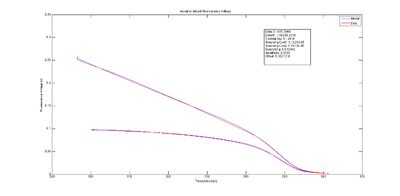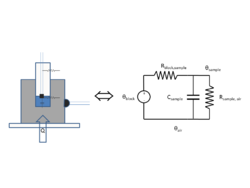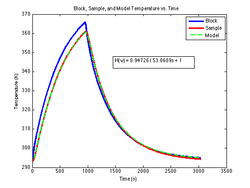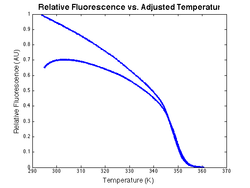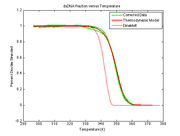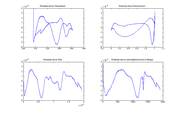DNA Melting: Model function and parameter estimation by nonlinear regression
Overview
In addition to the dsDNA concentration, the fluorescence voltage output, $ V_f $, depends of several factors, including:
- dynamics of the temperature cycling system
- $ \Delta H^{\circ} $ and $ \Delta S^{\circ} $
- thermal quenching of the fluorophore
- photobleaching
- responsivity and offset of the instrument
The goal is to write a model for $ V_f $ that takes these effects into account and use nonlinear regression to estimate the parameters.
Sample temperature
The DNA melter does not directly measure sample temperature. Sample temperature significantly lags behind block temperature.
Assumptions
- The RTD measures temperature of the metal heating block
- The sample has a constant heat capacity with uniform temperature throughout.
- The heating block has a much larger heat capacity than the sample, so the block can be modeled as a temperature source.
- The cuvette is modeled as a thermal resistance; its heat capacity is neglected.
- Heat escaping from the sample to the environment is modeled by a thermal resistance between the sample and room temperature
A circuit model for the heating system is shown in the figure. The circuit has a first-order, low-pass filter transfer function with two parameters:
- $ K_{thermal} $ is the low frequency gain of the system. In other words, if the heating block was set to 100° and the system was allowed to equilibrate for an infinite amount of time, the sample would reach a temperature of $ K_{thermal} \times 100^{\circ} $
- In response to a step increase in block temperature, the sample temperature would rise exponentially with time constant $ \tau_{thermal} $
Photobleaching
Excited dye molecules can react chemically with compounds in their environment and permanently lose their ability to fluoresce — a phenomenon called photobleaching. LED and ambient light illuminate the SYBR Green dye for 15 or more minutes over the course of a single melting and annealing cycle, which results in measurable photobleaching. Bleaching can be diminished by lowering the illumination; however, the signal is also proportionally reduced. Photobleaching can also be corrected by a mathematical model.
Assumptions
Photobleaching is a complicated phenomenon. The model proposed here adheres to Dr. George E. P. Box's excellent advice on modeling. Some of the assumptions are more suspect than others.
Which assumptions are probably significant sources of systematic error?
- The dye is divided into two populations, bleached and unbleached, with concentrations S and S
- The initial dye concentration is S + S
- Only dye molecules bound to dsDNA may be excited.
- Only excited fluorophore molecules bleach
- An excited fluorophore will either bleach with probability $ p $ or return to the ground state with probability $ 1-p $.
- The constant $ 1-p $ encompasses all of the mechanisms by which the fluorophore returns to the ground state unbleached, including fluorescence, phosphorescence, and non-radiative relaxation.
- Bleaching is irreversible.
- The number of molecules in the excited state is proportional to fluorescence.
- Bleached and unbleached molecules bind to dsDNA with the same affinity.
Model
Under these assumptions, the bleaching rate is proportional to fluorescence.
$ K_{bleaching} $ encompasses several constants, including $ p $, illumination intensity, optical gain of the instrument, and lock-in amplifier gain.
Setting the initial dye concentration to 1, the fraction of unbleached SYBR Green can be calculated by integrating:
Thermal quenching
SYBR Green I fluoresces less efficiently at higher temperatures. The decrease in fluorescence is approximately linear. Defining the dye efficiency at the initial temperature to be 1, quenching can be modeled by:
Instrument gain and offset
There are several optical and electronic gain factors in the DNA melter that determine the instrument responsively, $ \frac{\partial V_F}{\partial [{dsDNA}]} $. A constant, $ K_{gain} $accounts for the arbitrary scale of$ V_f $. In addition, $ V_f $ may be offset from zero when the dsDNA concentration is zero. $ K_{offset} $ is equal to the value of $ V_f $ when the dsDNA concentration is zero.

